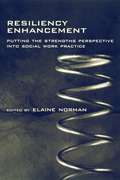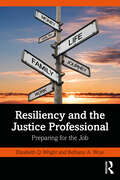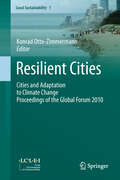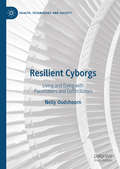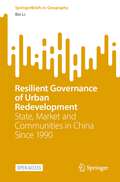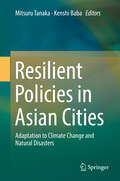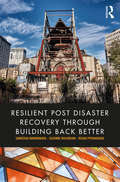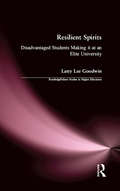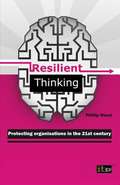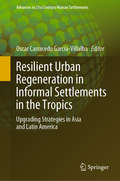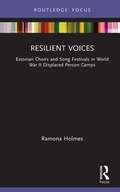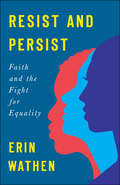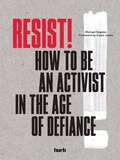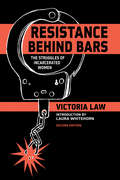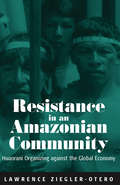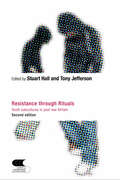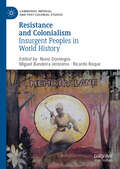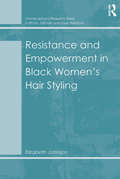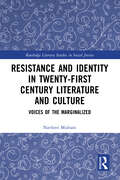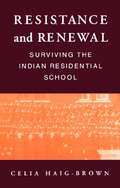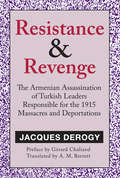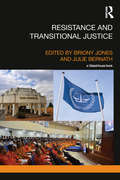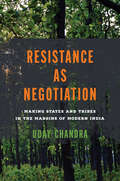- Table View
- List View
Resiliency Enhancement: Putting the Strength Perspective Into Social Work Practice (Social Work)
by Elaine NormanThis book bridges the gap between theory and implementation to illustrate how resiliency enhancement enables social workers to put the strengths perspective successfully into practice for their clients. Contributors to this volume show how social workers can use interventions to enhance those resiliency factors.
Resiliency and the Justice Professional: Preparing for the Job
by Elizabeth Q. Wright Bethany A. WryeThis essential text introduces criminal justice students to the topics of stress and wellness in personal and professional pursuits and provides them with the tools they will need to identify the signs of stress in their own lives and the lives of others. Students will be equipped to put words into practice through the development and practice of a personal wellness plan that will help them deal with the inevitable stressors they will experience on the job in the justice system.Written by a criminal justice professor with professional work experience in the field and a community/public health professor with expertise in health and wellness, this text prepares the instructor to discuss stress and its impact on the psychological and physical health of an individual and the process of resiliency-building. Each chapter includes exercises with both academic and real-world applicability that help students draw connections between the lessons and their usefulness for their personal, academic, and professional lives.Resiliency and the Justice Professional is ideal for all students interested in a career in the justice or justice-adjacent fields, at all degree levels, and can be used with students along the continuum of professional involvement — from those not yet employed in the field to veteran professionals seeking to expand their knowledge.
Resilient Cities 2
by Konrad Otto-ZimmermannAssembling papers originally presented at the Resilient Cities 2011 Congress in Bonn, Germany (June 2011), the second global forum on cities and adaptation to climate change, this volume is the second in a series resulting from this annual event. These cutting-edge papers represent the latest research on the topic and reflect the intensification of the debate on the meaning of and interaction between climate adaptation, risk reduction and broader resilience. Thus, contributors offer more material related to resilience, such as water, energy and food security; green infrastructure; the role of renewables and ecosystem services; vulnerable communities and urban poor; and responsive financing for adaptation and multi-level governance. Overall, the book brings a number of different perspectives to bear on the most pressing issues and controversies surrounding climate change adaptation in cities. These papers will prove invaluable to anyone interested in deepening their understanding of urban resilience and contributing to tackling climate change at the local level.
Resilient Cities: Cities and Adaptation to Climate Change - Proceedings of the Global Forum 2010
by Konrad Otto-ZimmermannEven with significant reductions of greenhouse gas emissions, a certain degree of climate change will inevitably occur. Adapting to climate change, then, will become a necessary step in reducing the vulnerability of many regions across the globe. This is especially true for urban areas where climate change has been shown to have particularly destabilizing effects. Through the identification and analysis of the most relevant impacts facing urban areas, this book makes clear the need to incorporate climate change concerns into the mainstream of local planning, governance and policy making practices. Adaptation as a workable concept within urban areas cannot be treated in isolation from the many pre-existing challenges facing cities. By offering numerous examples of ongoing adaptation programs and strategies across a wide range of contexts, the authors show the growing potential of cities in the fight against climate change. This book has its origins in a collection of papers originally presented at the Resilient Cities 2010 Congress in Bonn, Germany (May 2010), the first global forum on cities and adaptation to climate change, convened by ICLEI - Local Governments for Sustainability. In this volume, the first in a new series dedicated to this annual event, a range of contributors bring their perspectives to bear on the most pressing issues and controversies surrounding adaptation to climate change within cities. These writings will prove invaluable to anyone interested in understanding and confronting climate change at the local level.
Resilient Cyborgs: Living and Dying with Pacemakers and Defibrillators (Health, Technology and Society)
by Nelly OudshoornThis book examines how pacemakers and defibrillators participate in transforming life and death in high-tech societies. In both popular and medical accounts, these internal devices are often portrayed as almost magical technologies. Once implanted in bodies, they do not require any ‘user’ agency. In this unique and timely book, Nelly Oudshoorn argues that any discourse or policy assuming a passive role for people living with these implants silences the fact that keeping cyborg bodies alive involves their active engagement. Pacemakers and defibrillators not only act as potentially life-saving technologies, but simultaneously transform the fragility of bodies by introducing new vulnerabilities. Oudshoorn offers a fascinating examination of what it takes to become a resilient cyborg, and in the process develops a valuable new sociology of creating ‘resilient’ cyborgs.
Resilient Governance of Urban Redevelopment: State, Market and Communities in China Since 1990 (SpringerBriefs in Geography)
by Bin LiTo examine the origins, characteristics, and outcomes of resilient governance with Chinese characteristics, this open access book takes Guangzhou, a typical Chinese city from 1990 to 2015, as an example. Through participant observation, semi-structured interviews, and the collection of secondary data, this book finds that (1) the institutional context can be described as an authoritarian land-oriented pro-growth regime; (2) there are three phases with different patterns of governance: the Primitive Market Phase (1990–1998), the Pure Government Phase (1998–2006) and the Multiple Players Phase (2006–2015); (3) redevelopment can serve as a model of resilient governance because it changes in time in a dynamic environment to maximise economic growth; (4) an authoritarian land-oriented pro-growth regime is the key to support such a resilient governance model. This is an open access book.
Resilient Policies in Asian Cities: Adaptation to Climate Change and Natural Disasters
by Mitsuru Tanaka Kenshi BabaThis book presents a comprehensive framework and indicators that can be used to assess a city’s degree of resilience. Based on surveys using bottom-up assessment tools, it proposes the concept, framework and indicators of a resilient policy model (including some participatory approaches). It also presents case studies of this and similar tools applied to Japanese and Asian cities, the highlights including information not previously available in English. Today, the term “resilience” is prevalent in the context of sustainable societies. The IPCC AR5 published in 2014 again stressed the impact of climate change on natural disasters, while in March 2015 at the World Conference on Disaster Risk Reduction, the United Nations International Strategy of Disaster Reduction (UNISDR) published the Sendai Framework for Disaster Risk Reduction Action 2015-2030 , which serves as a guideline for local governments. Offering transdisciplinary perspectives from fields such as policy science, urban planning, environmental science, social psychology, management development and geography, this book discusses the lessons learned from Asian case studies, explaining the challenges and the effectiveness of the tools, and offering transdisciplinary insights for policymakers.
Resilient Post Disaster Recovery through Building Back Better
by Sandeeka Mannakkara Suzanne Wilkinson Regan Potangaroa<p>“Building Back Better” (BBB) has been a popular slogan in disaster recovery efforts around the world, including the 2004 Indian Ocean Tsunami, the 2009 Samoan Tsunami, the 2010 Haiti Earthquake and the 2011 Great East Japan Earthquake. BBB has recently been identified as one of four priorities of action for disaster risk reduction globally in the next 15 years by the United Nations Sendai Framework. However, there has consistently been a mismatch and confusion in the interpretation of the phrase and what BBB encapsulates which has made proper implementation difficult and unsuccessful at times. <p>This book explains the concept of “Building Back Better” as an innovative holistic approach to rebuilding a community following a disaster event in order to develop resilience. It begins by exploring the background, development and definitions of BBB. The theory behind establishing BBB as a holistic concept is explained and the internationally recognised BBB Framework developed by the authors is introduced and described. Each of the components of the Framework is explained in detail with findings from international research and case studies from the US, Haiti, Indonesia, Samoa, Sri Lanka, Vanuatu, Gaza, China, Australia, the UK and New Zealand, providing practical recommendations for implementation in recovery projects. There is a focus on the translation of BBB theory into practice to assist implementers to use the BBB Framework and BBB Indicators introduced in this book as effective tools to plan and implement disaster recovery projects. <p>This publication can be used as a handbook by government, non-governmental and private industry practitioners to prepare for and implement post disaster recovery projects that benefit and strengthen local communities and as a core text on international Disaster and Energy Management courses.</p>
Resilient Recovery from Disasters: The Long-Term Outcomes of Post-Disaster Housing Reconstruction in India, Thailand and Japan
by Elizabeth Maly Mittul Vahanvati Titaya SararitThis book is a call to action for housing recovery policymakers and practitioners to leverage foresight and planning capacities to achieve long-term resilience. For human societies to thrive in a rapidly changing climate and uncertain future, it is essential to learn about factors that can catalyse systemic change through disaster recovery processes. This book identifies key factors in housing recovery that meets housing rights of the most vulnerable, as well as help leapfrog to resilience strengthening of housing, its residents and institutions. To capture diverse experiences of stakeholders in various economies, socio-cultural, technical and political contexts, the authors draw from six cases of post-disaster housing reconstruction and rehabilitation projects from larger recovery programs, from three Asian countries – India, Thailand and Japan. This book identifies both unique and common findings. It is an essential resource for disaster recovery and housing practitioners, policymakers, students and researchers.
Resilient Spirits: Disadvantaged Students Making it at an Elite University (RoutledgeFalmer Studies in Higher Education)
by Latty Lee GoodwinThis study explores the identity construction of socioeconomically and educationally disadvantaged students who enter an elite university. This critical ethnography gathered qualitative data about the twenty-three participants through non-participant observation, in-depth interviews, and focus groups. Faculty, staff, and administrators were also interviewed.
Resilient Thinking
by Phillip WoodIt'll never happen to us . . . Or will it? There are no guarantees. Disasters happen. Can you be sure they won't happen to your organisation? And are you prepared if they do? No two businesses are the same. They all have different objectives, different values and different ways of working. External factors always have an effect - good or bad - and the impact is different for every company. In times of crisis, the effectiveness of 'one-size-fits-all' plans and checklists is, therefore, limited. In Resilient Thinking, Phillip Wood discusses the importance of thinking laterally about potential impacts on your organisation and examines a new approach to resilience management. As you read this book you will learn how to recognise potential risks and threats, put cost-effective and workable plans into place and minimise the impact of an incident. Your efficiency and profitability will improve, as you critically assess your organisation's and your own strengths and weaknesses and are able to make reasoned, rather than impulsive, decisions within the current business climate. You will know how to protect your assets and key stakeholder relationships, and how to obtain the buy-in of all departments and employees. Resilient Thinking will help you maintain your competitive edge, as you draw on knowledge gained through your experience and that of your competitors. Resilient Thinking will revolutionise your approach to risk analysis and crisis management. Even if the worst does happen, you will be fully equipped to handle it. About the author Phillip Wood MBE has extensive knowledge and experience in a wide range of security and resilience disciplines. He has delivered security, resilience and business continuity education and consultancy in a number of different countries and to numerous organisations. . He is currently Head of the Department of Security Studies at Buckinghamshire New University. Be equipped. Be prepared. Be ready.
Resilient Urban Regeneration in Informal Settlements in the Tropics: Upgrading Strategies in Asia and Latin America (Advances in 21st Century Human Settlements)
by Oscar Carracedo García-VillalbaThis book focuses on the implementation of slum upgrading projects and the last generation of citywide programmes that define the future urban configuration of informal settlements, from a citywide perspective, in the Earth’s tropical region. The book presents a study on regeneration experiences in Asia and Latin America and it identifies important points of connection and similarities between the two cases, while also determining that, compared to Asia, informality in Latin America is in its ‘second generation.’
Resilient Voices: Estonian Choirs and Song Festivals in World War II Displaced Person Camps
by Ramona HolmesThe aftermath of World War II sent thousands of Estonian refugees into Europe. The years of Estonian independence (1917-1940) had given them a taste of freedom and so relocation to displaced person (DP) camps in post-war Germany was extremely painful. One way in which Estonians dealt with the chaos and trauma of WWII and its aftermath was through choral singing. Just as song festivals helped establish national identity in 1869, song festivals promoted cultural cohesiveness for Estonians in WWII displaced person camps. A key turning point in hope for the Estonian DPs was the 1947 Augsburg Song Festival, which is the center point of this book. As Estonian DPs dispersed to Australia, Canada, Europe, and the United States these choirs and song festivals gave Estonians the resilience to retain their identity and to thrive in their new homes. This history of Estonian WWII DP camp choirs and song festivals is gathered from the stories of many courageous individuals and filled with the tenacious spirit of the Estonian singing culture. This work contributes to an understanding of immigration, identity, and resilience and is particularly important within the field of music regarding music and healing, music and identity, historical musicology, ethnomusicology, and music and politics.
Resist and Persist: Faith And The Fight For Equality
by Erin WathenOver the past few decades, the roles women play in public life have evolved significantly, as have the pressures that come with needing to do it all, have it all, and be all things to all people. And with this progress, misogyny has evolved as well. Today's discrimination is more subtle and indirect, expressed in double standards, microaggressions, and impossible expectations. In other ways, sexism has gotten more brash and repulsive as women have gained power and voice in the mainstream culture. <P><P>Patriarchy is still sanctioned by every institution: capitalism, government, and even--maybe especially--the church itself. This is perhaps the ultimate irony--that a religion based on the radical justice and liberation of Jesus' teachings has been the most complicit part of the narrative against women's equality. If we are going to dial back the harmful rhetoric against women and their bodies, the community of faith is going to have to be a big part of the solution. <P><P>Erin Wathen navigates the complex layers of what it means to be a woman in our time and place--from the language we use to the clothes that we wear to the unseen and unspoken assumptions that challenge our full personhood at every turn. Resist and Persist reframes the challenges to women's equality in light of our current culture and political climate, providing a new language of resistance that can free women and men from the pernicious power of patriarchy.
Resist!: How to Be an Activist in the Age of Defiance
by HuckResist! is the indispensable how-to guide for people looking to make a stand. Included are solid pieces of advice, practical tips and inspirational stories from those who have already successfully stood up and made a difference. Learn the principles of direct action, discover strategies for tackling social media, unearth ideas for motivating others, and understand how to get access to the people in power and get your message across.With a foreword by columnist, campaigner and best-selling author Owen Jones which unravels the political world and underlines why now is the time to act.
Resistance Behind Bars: The Struggles of Incarcerated Women
by Victoria Law Laura WhitehornAs it examines daily struggles against appalling prison conditions and injustices, this collection of real-life prisoners' stories and analysis of the prison landscape as it is today documents both collective organizing and individual resistance among women incarcerated in the United States. In 1974, women imprisoned at New York's maximum-security prison at Bedford Hills staged what is known as the August Rebellion. Protesting the brutal beating of a fellow prisoner, the women fought off guards, holding seven of them hostage, and took over sections of the prison. While many have heard of the 1971 Attica prison uprising, the August Rebellion remains relatively unknown even in activist circles. Resistance Behind Bars challenges and seeks to change such oversights. Emphasizing women's agency in resisting the conditions of their confinement through forming peer education groups, clandestinely arranging ways for children to visit mothers in distant prisons, and raising public awareness about their lives, the book will spark further discussion and research into the lives of incarcerated women and galvanize much-needed outside support for their struggles. This updated and revised edition includes a new chapter about transgender, transsexual, intersex, and gender-variant people in prison and the specific challenges that they face.
Resistance In An Amazonian Community
by Lawrence Ziegler-OteroLike many other indigenous groups, the Huaorani of eastern Ecuador are facing many challenges as they attempt to confront the globalization of capitalism in the 21st century. In 1991, they formed a political organization as a direct response to the growing threat to Huaorani territory posed by oil exploitation, colonization, and other pressures. The author explores the structures and practices of the organization, as well as the contradictions created by the imposition of an alien and hierarchical organizational form on a traditionally egalitarian society. This study has broad implications for those who work toward "cultural survival" or try to "save the rainforest."
Resistance Through Rituals: Youth Subcultures in Post-War Britain (Cultural Studies Birmingham)
by Stuart Hall Tony JeffersonThis revised and expanded edition of Resistance through Rituals includes a new introduction to bring the reader fully up-to-date with the changes that have happened since the work’s first release in the double issue of Working Papers in Cultural Studies in 1975. The work of the Centre for Contemporary Cultural Studies at Birmingham has been noted as historically leading the field in new areas of enquiry within the field of cultural studies, and the papers from the Centre are canonical reading for many cultural studies students. This revised edition includes all the original, exceptional papers, and enhances these with the reflections of the editors thirty years after the original publication. At a time when youth culture had been widely publicised, but few people understood its significance as one of the most striking and visible manifestations of social and political change, these papers redressed the balance. Looking in detail at the wide range of post-war youth subcultures, from teds, mods and skinheads to black Rastafarians, Resistance through Rituals considers how youth culture reflects and reacts to cultural change. This text represents the collective understanding of the leading centre for contemporary culture, and serves to situate some of the most important cultural work of the twentieth century in the new millennium.
Resistance and Colonialism: Insurgent Peoples in World History (Cambridge Imperial and Post-Colonial Studies Series)
by Ricardo Roque Miguel Bandeira Jerónimo Nuno DomingosThis volume offers a critical re-examination of colonial and anti-colonial resistance imageries and practices in imperial history. It offers a fresh critique of both pejorative and celebratory readings of ‘insurgent peoples’, and it seeks to revitalize the study of ‘resistance’ as an analytical field in the comparative history of Western colonialisms. It explores how to read and (de)code these issues in archival documents – and how to conjugate documental approaches with oral history, indigenous memories, and international histories of empire. The topics explored include runaway slaves and slave rebellions, mutiny and banditry, memories and practices of guerrilla and liberation, diplomatic negotiations and cross-border confrontations, theft, collaboration, and even the subversive effects of nature in colonial projects of labor exploitation.
Resistance and Empowerment in Black Women's Hair Styling (Interdisciplinary Research Ser. In Ethnic, Gender And Class Relations Ser.)
by Elizabeth JohnsonElizabeth Johnson's Resistance and Empowerment in Black Women's Hair Styling develops the argument that one way Black women define themselves and each other, is by the way they style/groom their hair via endorsement by the media through advertisement, idealized identification of Black female celebrities, and encouragement by professional celebrity hair stylists who serve as change agents. As a result, hair becomes a physical manifestation of their self-identity, revealing a private and personal mindset. Her research answers the following questions: What is the relationship between Black females' choice of hairstyles/grooming and transmitted messages of aesthetics by the dominant culture through culturally specific magazines?; What role do the natural hair blogs/vlogs play as a change agent in encouraging or discouraging consumers grooming their hair in its natural state?; What impact does a globalized consumer market of Black hair care products have on Hispanic/Latinas and Bi-Racial women?; Are Black female Generation Y members more likely to receive backlash for failure to conform their hair to dominant standards in their hair adornment in the workplace? Johnson thus demonstrates that the major concern from messages sent to Black women about their hair is its impact on Black identity. Thus, the goal of Black women should be to break with hegemonic modes of seeing, thinking, and being for full liberation. This critical and deep consciousness will debunk the messages told to Black women that their kinky, frizzy, thick hair is undesirable, bad, unmanageable, and shackling.
Resistance and Identity in Twenty-First Century Literature and Culture: Voices of the Marginalized (Routledge Literary Studies in Social Justice)
by Navleen MultaniResistance and Identity in Twenty-First Century Literature and Culture: Voices of the Marginalized is a compendium of reflections on literary texts, politics of literature and culture. The book proffers ruminations on the pivotal role of constructive and positive resistance to reconstruct identities for meaningful human existence. The disciplinary power and dominance coerce the natural body to resist and yearn for freedom. One can establish unique identity by refusing to conform to pressures of society that deform the natural body. Dominant forces and oppressive structures evoke resistance that can range from 'polite demurral' to 'refusal'. Resistance comes from the 'will' that refuses to be controlled and governed. The 'refusal' of the ordinary illuminates ordinary lives/ bodies. Language and literary texts contain essential truths of such human existence. Words and imaginary worlds in literary works reveal truth and suggest possibilities for reconfiguring the order.
Resistance and Renewal
by Celia Haig-BrownOne of the first books published to deal with the phenomenon of residential schools in Canada, Resistance and Renewal is a disturbing collection of Native perspectives on the Kamloops Indian Residential School(KIRS) in the British Columbia interior. Interviews with thirteen Natives, all former residents of KIRS, form the nucleus of the book, a frank depiction of school life, and a telling account of the system's oppressive environment which sought to stifle Native culture.
Resistance and Revenge: Armenian Assassination of Turkish Leaders Responsible for the 1915 Massacres and Deportations
by Jacques DerogyInitially published in French under the title Operation Nemesis, this revealing work is now available to the English-speaking public for the first time. It ranks as a major revision in the historic study of the Armenian resistance to the Ottoman genocide of Armenians.Operation Nemesis is a study of the Armenian Revolutionary Federation (the Tashnak Party) and the individuals responsible for the execution of Turkish leaders. Until Derogy's book, it had been assumed that the assassins were acting out of personal and emotional motives. But through an amazing amount of detective work, it becomes clear that they were in fact part of a disciplined effort to seek retribution for historic crimes against the Armenian people.The work richly details Turkish plans for the liquidation of the Armenian people, the individuals selected to liquidate the genocidists, and above all, and most complex, to document for the first time the role of the organized Armenian political opposition to Turkish rule. In doing so, Derogy brings to light the relation between the legal party and its extra-legal arm; the mechanisms needed to implement the daring plan of assassination; and the special postwar circumstances in which the Armenian nation found itself - torn asunder by a Turkish-Soviet detente in which the independence of Armenia became the sacrificial pawn.Derogy worked closely with scholars around the world, and interviewed firsthand remaining survivors who had direct contact with the events described. His is a detective story of the first rank, no less than a piece of historical reconstruction with obvious portent for current Armenian efforts to recapture political legitimacy and personal pride.
Resistance and Transitional Justice
by Briony Jones Julie BernathDespite a more reflective concern over the past 20 years with marginalised voices, justice from below, power relations and the legitimacy of mechanisms and processes, scholarship on transitional justice has remained relatively silent on the question of ‘resistance’. In response, this book asks what can be learnt by engaging with resistance to transitional justice not just as a problem of process, but as a necessary element of transitional justice. Drawing on literatures about resistance from geography and anthropology, it is the social act of labelling resistance, along with its subjective nature, that is addressed here as part of the political, economic, social and cultural contexts in which transitional justice processes unfold. Working through three cases – Côte d’Ivoire, Burundi and Cambodia – each chapter of the book addresses a different form or meaning of resistance, from the vantage point of multiple actors. As such, each chapter adds a different element to an overall argument that disrupts the norm/deviancy dichotomy that has so far characterised the limited work on resistance and transitional justice. Together, the chapters of the book develop cross-cutting themes that elaborate an overall argument for considering resistance to transitional justice as a subjective element of a political process, rather than as a problem of implementation.
Resistance as Negotiation: Making States and Tribes in the Margins of Modern India (South Asia in Motion)
by Uday Chandra"Tribes" appear worldwide today as vestiges of a pre-modern past at odds with the workings of modern states. Acts of resistance and rebellion by groups designated as "tribal" have fascinated as well as perplexed administrators and scholars in South Asia and beyond. Tribal resistance and rebellion are held to be tragic yet heroic political acts by "subaltern" groups confronting omnipotent states. By contrast, this book draws on fifteen years of archival and ethnographic research to argue that statemaking is intertwined inextricably with the politics of tribal resistance in the margins of modern India. Uday Chandra demonstrates how the modern Indian state and its tribal or adivasi subjects have made and remade each other throughout the colonial and postcolonial eras, historical processes of modern statemaking shaping and being shaped by myriad forms of resistance by tribal subjects. Accordingly, tribal resistance, whether peaceful or violent, is better understood vis-à-vis negotiations with the modern state, rather than its negation, over the past two centuries. How certain people and places came to be seen as "tribal" in modern India is, therefore, tied intimately to how "tribal" subjects remade their customs and community in the course of negotiations with colonial and postcolonial states. Ultimately, the empirical material unearthed in this book requires rethinking and rewriting the political history of modern India from its "tribal" margins.
